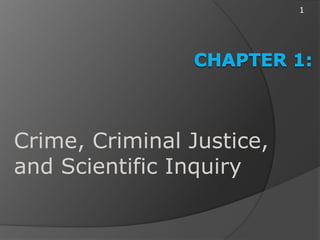
Ch01 Crime, Criminal Justice, and Scientific Inquiry
- 1. 1 Crime, Criminal Justice, and Scientific Inquiry
- 2. OUTLINE Introduction: Why Study Research Methods? How We Know What We Know Personal Human Inquiry Errors in Personal Human Inquiry and the Corresponding Safeguards Foundations of Social Science Purposes of Research Differing Avenues for Inquiry Knowing Through Experience
- 3. 3 • Criminal Justice professionals are both consumers and producers of research • Understand how research is conducted, evaluated, interpreted, and presented • Need to know how to competently apply scientific methods to Criminal Justice phenomena
- 4. 4 • Experiential Reality: the things we know from direct experience (touching a stove) • Agreement Reality: the things we consider real because we have been told they are real, and everyone agrees (sun sets in the West) Kansas City Preventive Patrol Experiment
- 5. 5 • Empirical Research: the production of knowledge based on experience or observation • Certain criteria to be met • An assertion must have both logical and empirical support • Epistemology: the science of knowing • Methodology: the science of finding out Science offers an approach to both experiential reality and agreement reality
- 6. 6 • We use causal and probabilistic reasoning • Future circumstances are caused or conditioned by present ones • The patterns of cause and effect are probabilistic in nature • Science makes causality and probability more explicit • The goal is to understand why certain things are related, why patterns occur, to enable us to make more accurate predictions
- 7. 7 • Tradition: Things that “everyone knows” • Ex: Driving on the left side of the road in the US is dangerous • Authority: Trusting the judgment of someone with special expertise • Ex: You are more likely to believe a Judge regarding your driver’s license suspension than your parents • Both provide us with a starting point for our own inquiry
- 8. 8 •Inaccurate Observation – Use measurement devices •Overgeneralization – Large sample of observation & Replication •Selective Observation – Pre-specify the number and types of observations
- 9. •Illogical Reasoning – Use systems of logic consciously and explicitly •Ideology and Politics – Guard against its influence •To Err is Human – Take precautions to avoid error
- 10. 10 •Science is logico-empirical •The Two Pillars of Science: •Logic or Rationality •Observation •Social Scientific Theory: Discovering what is, not what should be •Cannot settle debates on value or worth •Problematic with Evaluators •Ex: What Constitutes a good Parole Officer?
- 11. 11 •Social Science aims to find patterns of regularity in social life •Norms and rules and observations in society create regularity •Ex: A person is not eligible for a driver’s license until a certain age •Social regularities represent probabilistic patterns • A general pattern does not have to be reflected in 100% of the observable cases to be a pattern
- 12. 12 •Social scientists study social patterns, not individual ones •Aggregates are more often the subject of social science research •Distinguishes the activities of criminal justice researchers from the daily routines of most criminal justice practitioners •Ex: Processing and classifying new inmates
- 13. 13 •Theory is written in a variable language; people are the carriers of those variables •Social science involves the study of these two concepts: •Attributes - Characteristics or qualities that describe some object such as a person (Ex: “married”) •Variables - Logical groupings of attributes (Ex: occupations)
- 14. 14 •Theories describe the relationships that might be logically expected among variables •Causation: A person's attributes on one variable are expected to cause or encourage a particular attribute on another variable •Independent Variable – “cause”, “influencer” •Dependent Variable – “effect”, “depends” •Ex: Type of defense attorney prison or probation
- 15. 15 •Explore the nature or frequency of a problem or policy •Might also collect data on some measure to serve as a baseline for later comparisons •Also appropriate when some type of policy change is being considered •May be simple or complex
- 16. 16 •Describe the scope of a problem or policy response •Make more accurate and formal observations •Often concerned with counting or documenting observations; exploratory studies focus more on developing a preliminary understanding •Ex: US Census, UCR •Following exploration, we want to know the problem’s frequency/prevalence/degree/scope
- 17. 17 •Explain things – answers “why?” •Why have we seen a certain change in scope? •Why does a certain problem exist? •Ex: Why do some people write computer viruses?, Why do some people assault their spouses?
- 18. 18 •Applied research is often used to evaluate the effects of specific criminal justice programs •Two major types of applied research: •Evaluation research – Comparing program goals to results •Policy analysis – Prospective – Anticipate future consequences of alternative actions
- 19. 19 •Ideographic Explanation - When we attempt to explain a single situation exhaustively •Fully understand the causes of what happened in this particular instance; comprehensively explain one case •Nomothetic Explanation – Seeks to explain a class of situations or events rather than a single one •Explains efficiently; settles for partial explanation
- 20. 20 •Moves from the general to the specific •From a logically or theoretically-expected pattern to observations that test the presence of the pattern •“why something happens” “whether it actually does”
- 21. •Inductive – moves from the specific to the general •From a set of observations to the discovery of a pattern among them •“why something happens” “whether it actually does”
- 22. 22 •All observations are qualitative at the outset •Qualitative: Non-numerical •Greater richness of meaning •Quantitative: Numerical •Carries a focusing of attention and specification of meaning •Both are useful and legitimate – choose based on topic or combine aspects of both
- 23. •Empirical research involves measurement and interpretation •Measurement: Researchers measure aspects of reality and then draw conclusions about the meaning of what they have measured •Interpretation: Very much dependent on how observations are structured